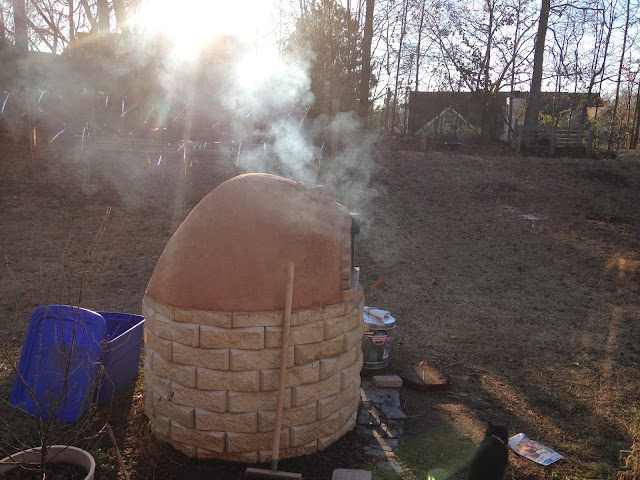Beef Wellington is one of those intimidating “wow factor” dishes consisting, with some variation, of a seared filet mignon smothered
in a whole-grain mustard and duxelles (mushrooms that have been pulverized into a paste), and puff
pastry. The whole package is then baked until the crust crisps up and the meat
reaches medium-rare perfection. It
looks damn impressive and holds delicious layers of flavor.
Here, my
daughter and son-in-law are taking on this ambitious project putting together individual
Beef Wellingtons that they adapted from Gordon Ramsay's version, along with pan roasted
tri-colored fingerling potatoes and haricots verts, to celebrate several recent events in their life - George's birthday, his earning a PhD and their
first dinner in their new home. Important life passages like those require a special meal like this!
Check out these photos -
How it's done -
INGREDIENTS
For mushroom duxelles:
1 tablespoon
extra-virgin olive oil
1/2 teaspoon salt
1/4 teaspoon black
pepper
1 pound cremini
mushrooms, coarsely chopped
For herb crepe:
2 eggs
1 teaspoon sugar
1/2 teaspoon salt
2 tablespoons chives, minced
1/2 cup whole milk
1/4 cup water
4 tablespoons butter, melted, plus more if
needed for pans
1/2 cup all-purpose flour
For Beef Wellington:
2 pounds filet mignon
Salt and black pepper, to taste
2 tablespoons olive oil
1/4 cup whole-grain Dijon mustard
1/2 pound prosciutto di Parma
1 sheet puff pastry, thawed
1 egg yolk
1 tablespoon whole milk
DIRECTIONS
To make mushroom duxelles:
Add mushrooms to a food processor and process
until completely smooth. The consistency is similar to wet hummus.
In a pan over medium heat, add mushroom paste,
olive oil, salt, and pepper. Spread the mixture evenly over the surface and
cook on a medium-low heat until the moisture in the paste has reduced and the
mixture has the consistency of a spreadable pâté. Remove from heat and let cool.
To make herb crepes:
In a large bowl, whisk together flour, eggs,
sugar, salt, and chives. Whisk in milk, water, and 1 tablespoon of melted
butter, until smooth and emulsified.
Heat a crepe pan or large skillet over medium
heat. Add remaining 3 tablespoons of butter.
Add 1/4 cup of the batter. Rotate pan in a
circular motion over the heat to completely cover the surface with the batter.
The edges of the crepe will begin to curl slightly as the crepe cooks. Cook for
approximately 45 to 60 seconds, then flip crepe to cook the other side. Each
side should be a pale golden brown. Remove from heat. Add more butter if needed
to the pan and repeat process with the remaining batter. Set crepes aside.
Preheat the oven to 400º F.
To make steaks:
Pat filet mignon dry with paper towels and
season generously with salt and black pepper.
Heat a skillet over medium-high heat and add
olive oil. When the oil begins to smoke, add the filet mignon and brown from 1
to 2 minutes on all sides. You want to create a nice sear on the outside of the
steak but leave the inside raw. Remove from heat and place on a cutting board
to cool.
Cover cooled filet with Dijon mustard.
To roll the beef Wellingtons:
On a cutting board, lay out a long piece of
plastic wrap. In the middle of the wrap, lay out a crepe. Spread mushroom
duxelles over the crepe. Lay out the prosciutto on top of the duxelles. Place
filet in the center of the crepe and gently wrap the crepe around the filet.
Trim off any excess and use the plastic wrap to tightly wrap the steak.
Lay out a clean, long piece of plastic wrap.
Gently roll out puff pastry until it is a 1/4-inch thin. Place the wrapped
steak on one end of the puff pastry and wrap. Pinch the ends closed and trim
off any excess puff pastry. Use the plastic wrap to tightly seal the puff
pastry. Pop it in the fridge for about 5 minutes to let it firm up again.
In a bowl, mix together egg yolk and milk.
Place a sheet of parchment paper or aluminum
foil on a baking sheet.
Remove Wellington from fridge, remove the
plastic wrap, and lay the Wellington seam-side down
on the baking sheet. Baste the top of the puff pastry with the egg wash
and bake for approximately 25 to 30 minutes or until the internal temperature
of the steak reaches 125º F, or to whatever temperature you prefer your steak.
Remove from the oven and let rest for at least
10 minutes before slicing into medallions.
Serve warm.
















































